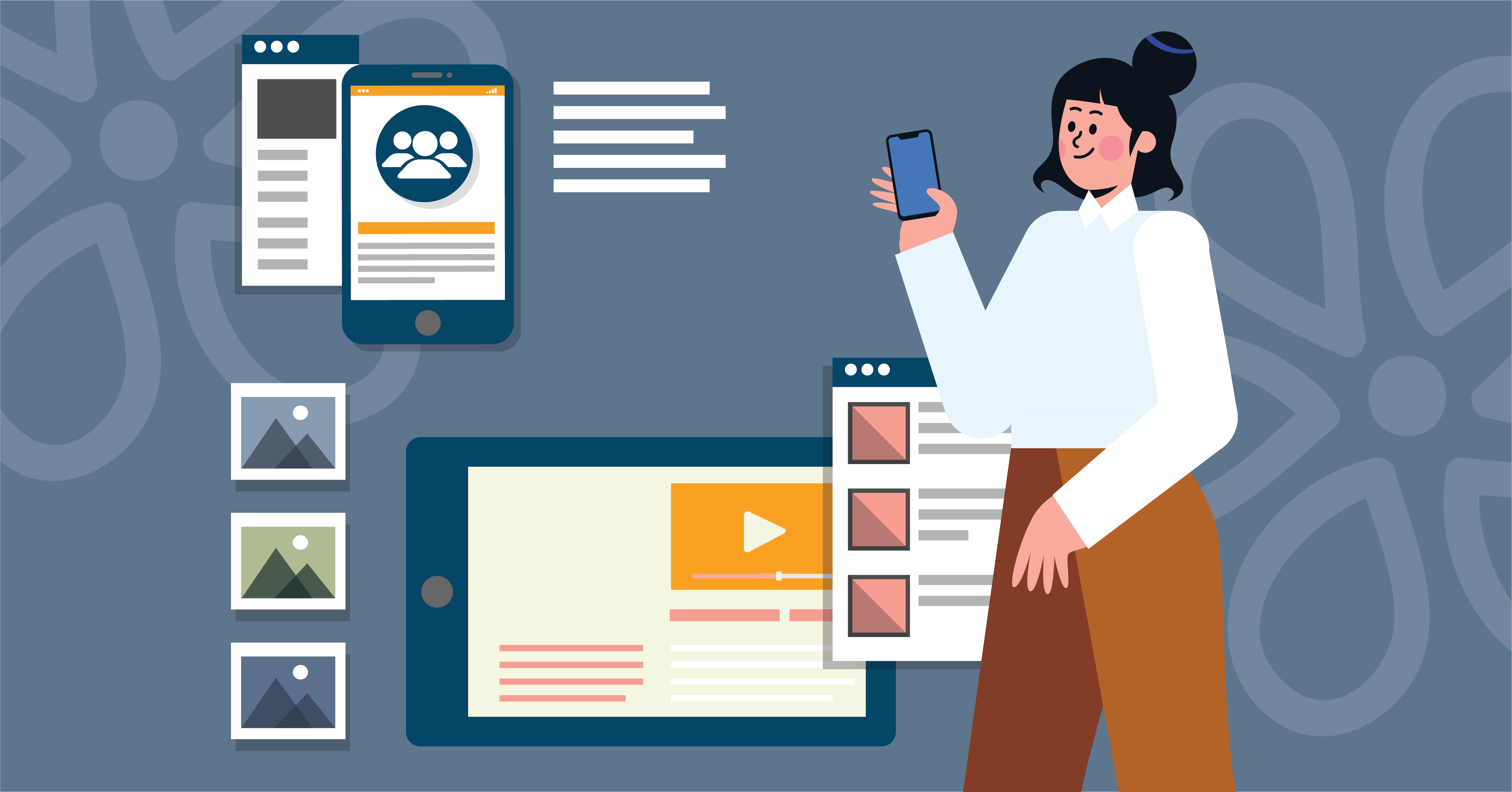Do you need help with leveraging media channels for marketing? Gain insights into using social media, email marketing, and more for strategic brand awareness.
Channel surfing doesn’t just refer to TV channels anymore. Audiences interact with thousands of media channels daily, from radio to print ads, various social media apps, and more. Understanding different media channels can help you choose how to send a message that engages and impacts audiences, no matter your industry. To help you understand these nuances, we’ll explore the variety of traditional and digital media channels, the future of media channels, and how you can choose channels, assess their impact, and build an omnichannel media strategy that works for your brand.
But first, the basics. What is a media channel?
What Is a Media Channel?
Simply put, a media channel is any platform or means of communication to transmit information or content to an audience. Imagine you want to share a recipe with your friends. You could write it down on a piece of paper, email it, hire someone to go to each of your friends’ houses and tell them the recipe, or shout it from your window once your friends are assembled on the street below. Each of these examples represents a different media channel with its own characteristics and reach.
Media channels bridge the gap between creators and viewers. Effective channels ensure the information or content arrives at the intended destination. Media channels act as pipelines, directly delivering material – news, entertainment, education, and more – to targeted audiences. Every channel caters to specific preferences and habits, like a radio station playing music for car commuters or a social media platform building niche micro-communities.
Understanding the benefits of different media channels and how to incorporate them into your marketing campaigns is essential for connecting with your audience. These benefits and uses depend on your media channel, from traditional to digital and beyond. Let’s explore some specific media channel types.
Types of Media Channels
Every marketing strategy should include a blend of traditional and digital media channels – more on the importance of an omnichannel strategy later. But first, get acquainted with some channels you probably interact with daily.
Traditional Media
Traditional media channels generally refer to channels established before the adoption of the Internet. You are likely very familiar with these offline communication channels. They offer broad reach, trusted content, and unique engagement opportunities. Here are a few examples:
- Television: The king of mass media, television delivers moving images, sound, and stories into millions of homes simultaneously. Its benefits lie in capturing attention, evoking emotions, and building brand recognition through captivating visuals and storytelling.
- Radio: A constant companion for many, radio content offers on-the-go news, music, talk shows, and radio ads. With millions of us still tuning in, radio is a portable and affordable media channel for audiences, allowing brands to engage listeners as they go about their day. This is an effective channel for reaching busy audiences.
- Print Media: From print ads in newspapers and magazines to books and brochures, print media delivers lasting, tangible content. Long before the digital age, print media’s credibility and in-depth storytelling could be used to target specific demographics and interests through diverse formats.
- Outdoor Advertising: Out-of-home media like billboards, bus stop ads, and transit posters provide quick, impactful messages in public spaces. They can reach highly targeted audiences at specific locations and create lasting impressions.
- Direct Mail: One of the oldest offline channels, brochures, flyers, and letters delivered directly to mailboxes offer personalized attention and targeted messaging. Direct mail reaches specific demographics and households with tailored content, often resulting in high engagement rates.
Digital Media
While traditional media may have paved the way, digital channels have revolutionized communication, creating interactive spaces where content reigns supreme. From website display ads to social media posts, here’s a peek into some key players in digital advertising:
- Websites: Websites are your online home base, hosting information, content, and services on a landing page that users can easily find. Benefits include brand control and lead generation through conversion-focused calls to action.
- Search Engine Marketing (SEM): Using optimization techniques and paid ads, brands can leverage search engine results pages (SERPs) to reach their audience. Creating keyword-targeted content can benefit brands with targeted reach, increased website traffic, and the potential for qualified leads.
- Social Media Marketing (SMM): Brands can now engage with audiences on apps like Facebook, Twitter, or Instagram. Social media advertising boosts brand awareness, community building, and customer engagement, along with being the place where most demographics are tuned in.
- Email Marketing: Email marketing is ideal for sending targeted messages to subscribers, promoting products, sharing news, or building relationships. The cost-effectiveness, personalization, and measurable results brands can get from email marketing make it a valuable media channel.
- Video Marketing: Content marketing utilizing video content across platforms like YouTube, TikTok, Instagram, or other social media apps engages viewers with high-quality storytelling and can get brands increased website traffic.
- Podcasts: Podcasts, like radio, deliver audio content on specific topics or interests to build loyal audiences, drive thought leadership, and reach mobile listeners seeking educational and entertaining content.
- Webinars and Live Streaming: Hosting real-time online events for engagement and interaction can generate leads, educate potential customers on brand information, and showcase expertise.
- Influencer Marketing: Influencer marketing is becoming a requisite media channel. By collaborating with content providers who have established online followings to promote your brand or product, you get targeted reach, increased brand trust, and authentic endorsement.
Selecting the right marketing channels for your goals isn’t a game of chance. It’s a decision-making process that can make or break your campaign’s success. Each channel has its own strengths and weaknesses that can cater to different industries, audiences, and message formats. Choosing the wrong one can be like shouting into the void – reaching the wrong people with the wrong message and wasting your marketing resources.
When you choose the right channels, your message resonates with the right audience, maximizing engagement and driving conversions. It’s the difference between a scattered, ineffective campaign and a focused, laser-targeted effort that gets real results.
Measuring the Success of Media Channels
Just as choosing the right media channel is essential, so is tracking its effectiveness. Creating a feedback loop to gather data about the impact of your channel choices can help you design impactful and cost-effective marketing efforts in the future.
Analytics and Metrics
Success shouldn’t be a matter of blind intuition. Sustinable success is data-driven, guided by insightful analytics and meaningful metrics. Each channel’s data is unique – website traffic paints a different picture than views on social media platforms like TikTok. Engagement metrics like comments, shares, and dwell time reveal emotional resonance, while conversion rates and ROI speak to the bottom line. You can unlock a deeper understanding of audience behavior and campaign effectiveness by tracking these signals. A well-placed Instagram story might drive brand awareness, while a targeted blog post converts curious browsers into paying customers. The important part of data tracking and analytics is identifying the right metrics for each channel, interpreting them in context, and using them to tell an accurate story about your campaign’s impact.
Adjusting Strategies for Optimization
Data-driven insights pave the way for continuous improvement. Once you understand how each channel performs, you can fine-tune your strategies for maximum impact. A lagging engagement rate on Facebook ads might call for revamped visuals or a shift in target audience. A blog post overflowing with comments might inspire a deeper dive into search engine optimization. You may find that adding alt text to your Instagram posts boosts engagement. The beauty is in the iterative process – each tweak informs the next, leading to a more effective, audience-centric approach. Don’t be afraid to experiment, test different content formats, and analyze the results. Remember, data is not a static picture; you need to adjust your steps and find the approach that resonates with your audience. By embracing the interplay of analytics and action, you can transform your media channels into powerful engines of engagement and success.
Building an Effective Media Channel Strategy
Compared to single-channel or multi-channel marketing, an omnichannel strategy that merges offline and digital marketing channels can give you a leg up on the competition. Here’s a quick overview of how to start or adapt your media channel strategy with an omnichannel focus:
- Define your goals: What do you want to achieve? Brand awareness, lead generation, website traffic? Clarity on your goals drives direction on which media channels to use.
- Know your audience: Who are you trying to reach? Understanding demographics, interests, and online behavior is crucial for the same reason. Leverage data and technology to deliver relevant experiences for individual users across all touchpoints.
- Research the options: Explore different channels (social media, email, websites, out-of-home, etc.) and their strengths, as we covered above. Align them with your target audience and goals.
- Prioritize and mix: Focus on the most impactful channels but include an omnichannel mix for broader reach and deeper engagement.
- Develop a brand voice and tone: Create a uniform experience across your channels to ensure your audience flows effortlessly between channels. Brand voice and tone go a long way to creating a consistent brand experience.
- Create relevant content: Tailor content formats and topics to each channel’s strengths and your audience’s preferences.
- Plan your content calendar: Schedule posts, emails, and other activities, ensuring cross-channel coordination and avoiding information overload.
- Utilize automation tools: Leverage technology to streamline tasks, personalize messages, and maintain consistency.
- Track your performance: Monitor key metrics like engagement, reach, and conversions for each channel.
- Refine your approach: Analyze data, test different strategies, and adapt your content and channel mix based on what resonates with your audience.
By following these steps and embracing the interconnected nature of your channels, you’ll build a comprehensive media plan that resonates with your audience, drives engagement, and achieves your marketing goals via multiple media channels.
Future Trends in Media Channels
The future of media channels is hyper-personalization. The ability to create content that appeals to each individual is driven by a potent cocktail of artificial intelligence (AI), automation, and real-time marketing. Imagine news feeds curated in real-time based on your audience’s emotional state or advertising that anticipates a viewer’s needs before they express them. Automation and AI can do heavy lifting in content creation and distribution, freeing up human creativity for marketing strategy. Real-time marketing will turn every customer touch-point into a potential live conversion. From interactive advertisements adapting to their browsing history, AI-powered chat-bots asking personalized questions, or dynamic pricing adjusted based on purchase likelihood, touch-points can be about more than awareness.
Amidst these changes, one element will always remain important: the user experience. In this hyper-personalized landscape, brands prioritizing genuine emotional connection will stand out. AI won’t replace authentic storytelling. It will simply augment it. This augmentation will allow for deeper audience understanding and more nuanced narratives. In the future, we can expect to see media channels evolve into interactive playgrounds, blurring the lines between consumption and creation. The future of media channels is not just about delivering information; it’s about forging personal connections, fostering genuine engagement, and, ultimately, creating experiences that leave users feeling seen, heard, and truly understood.
Mastering Media Channels with First Media
With the amount of media channels you have to choose from, simply having a message isn’t enough. Understanding each channel – from social media’s lightning-fast trends to TV’s enduring reach – is the key to amplifying your voice and connecting with your audience. At First Media, our expertise in crafting data-driven strategies and mastering diverse platforms lets us unlock the full potential of any media channel to maximize engagement and drive meaningful results for your brand. Partner with First Media to master media channels.





